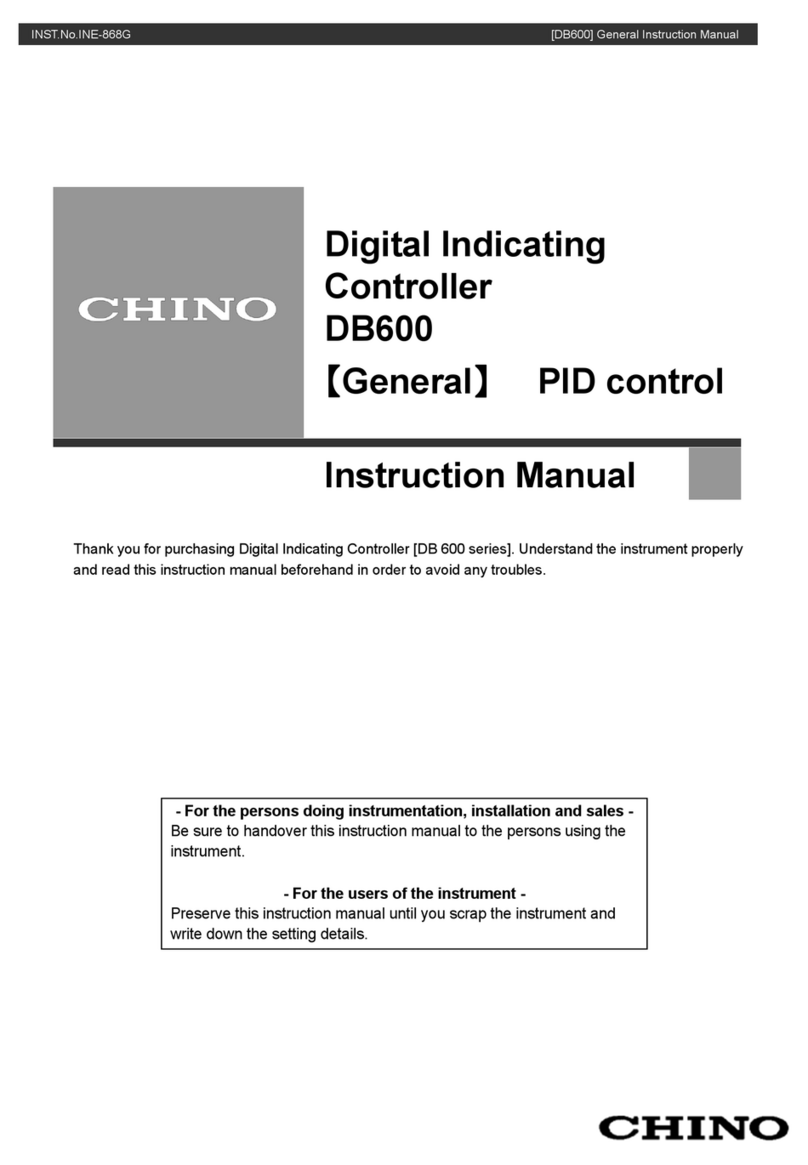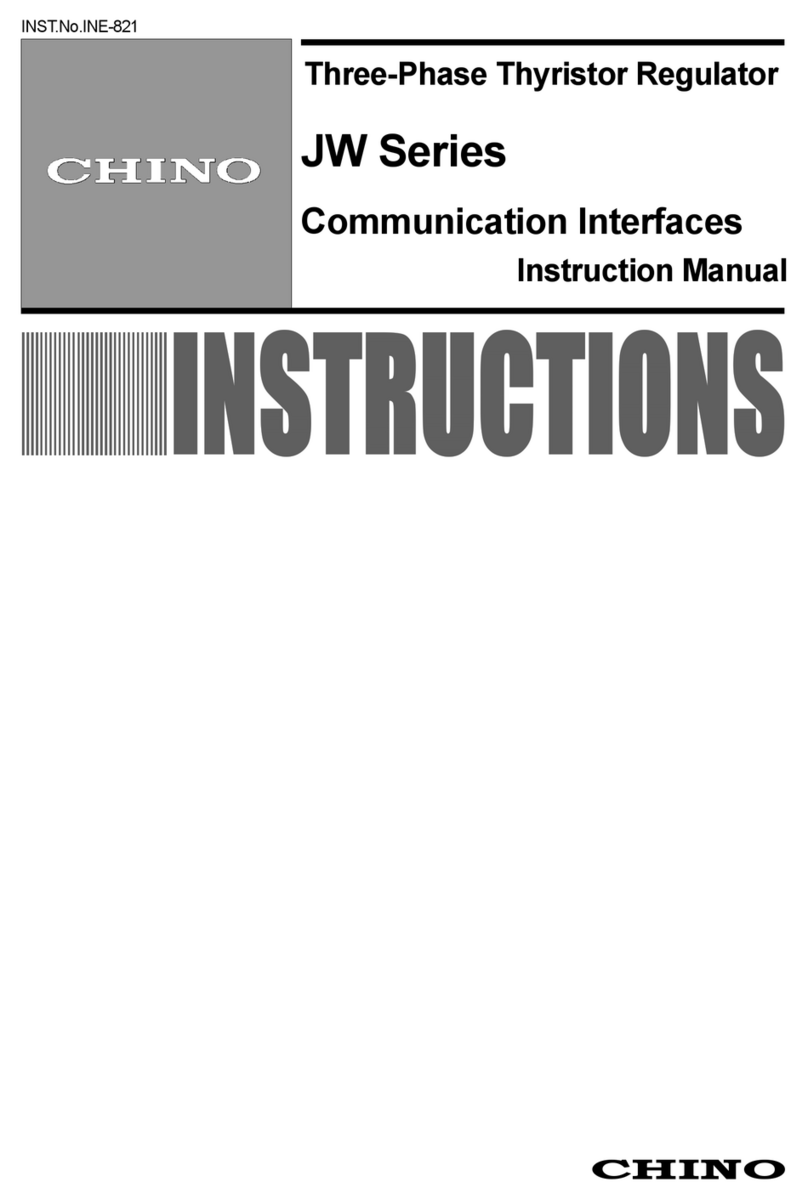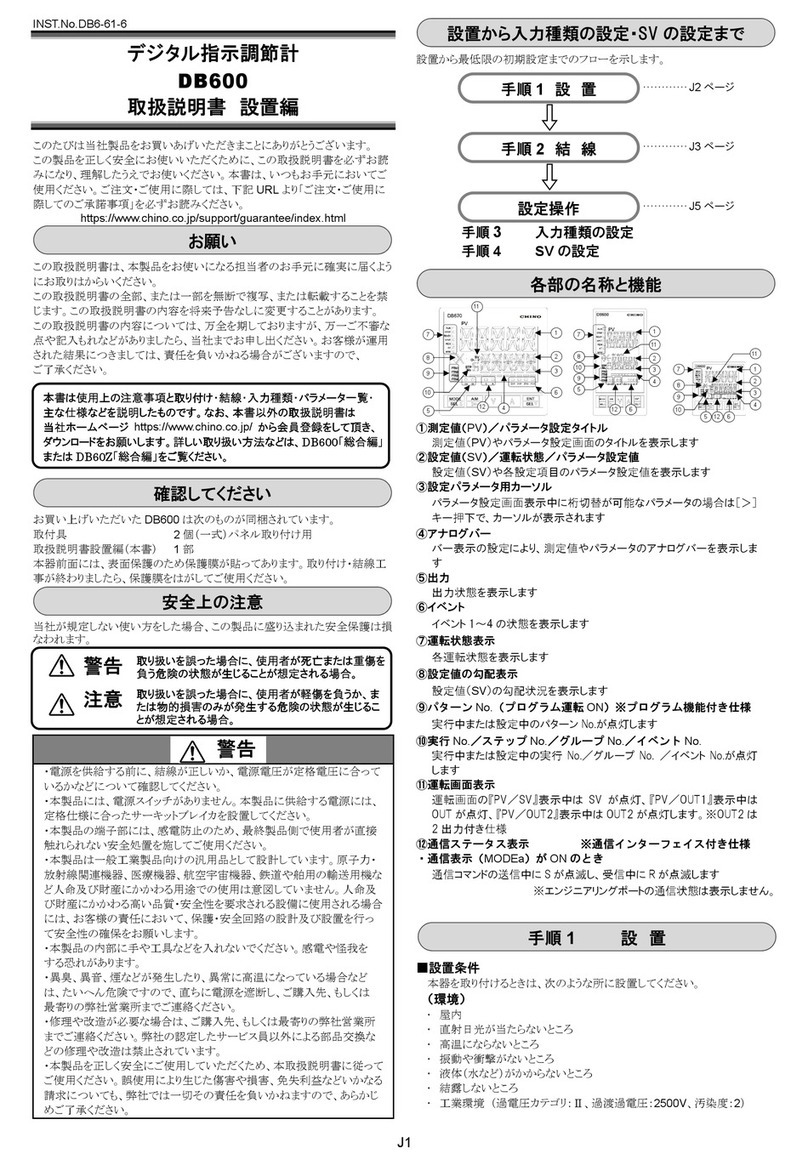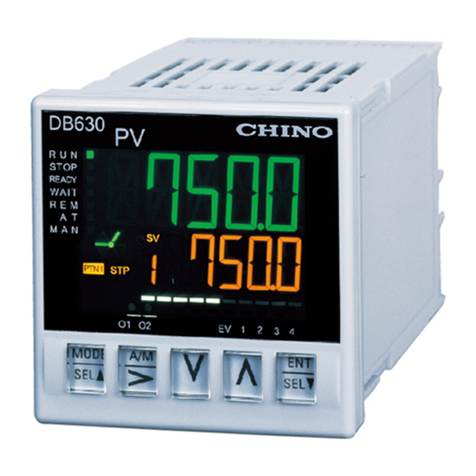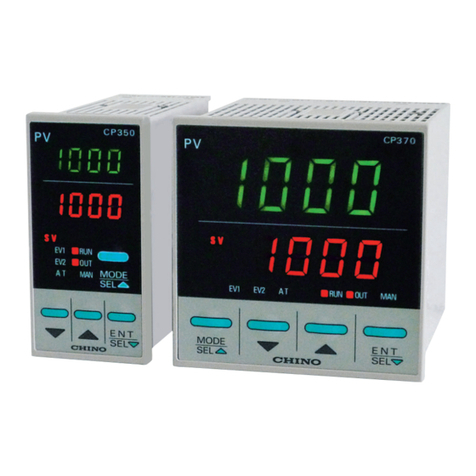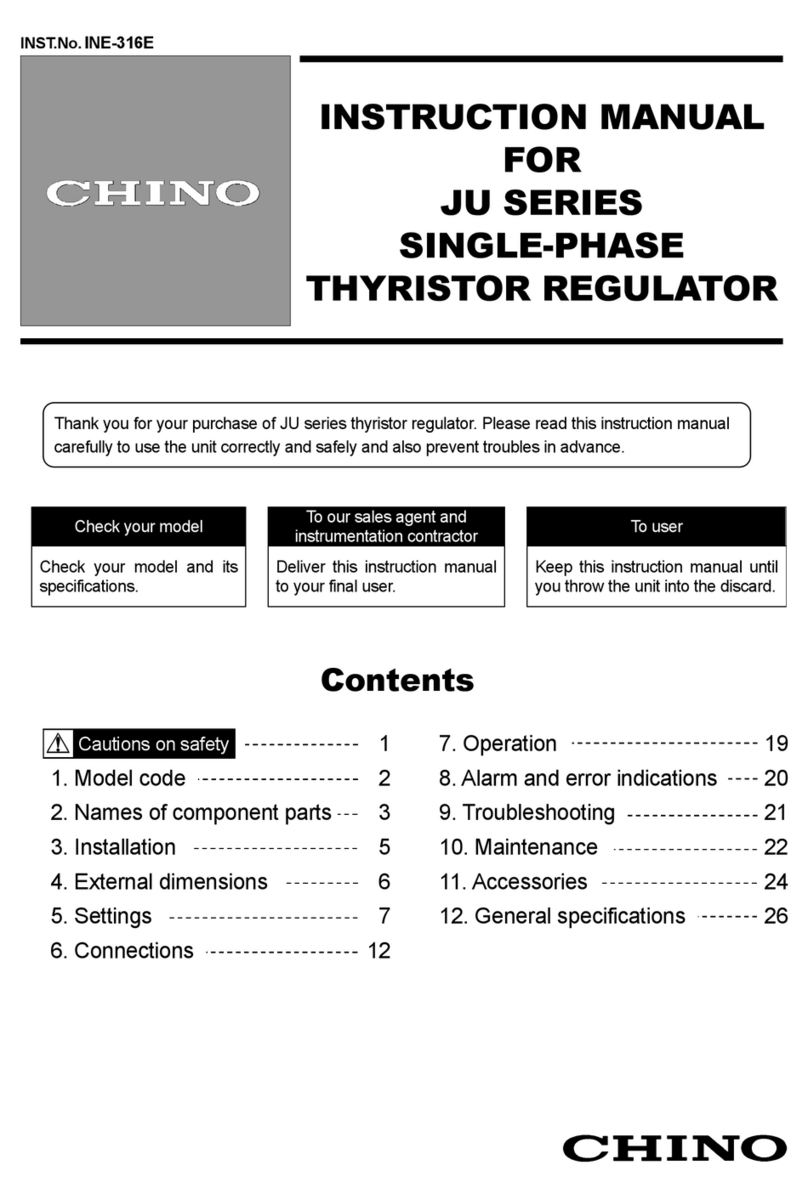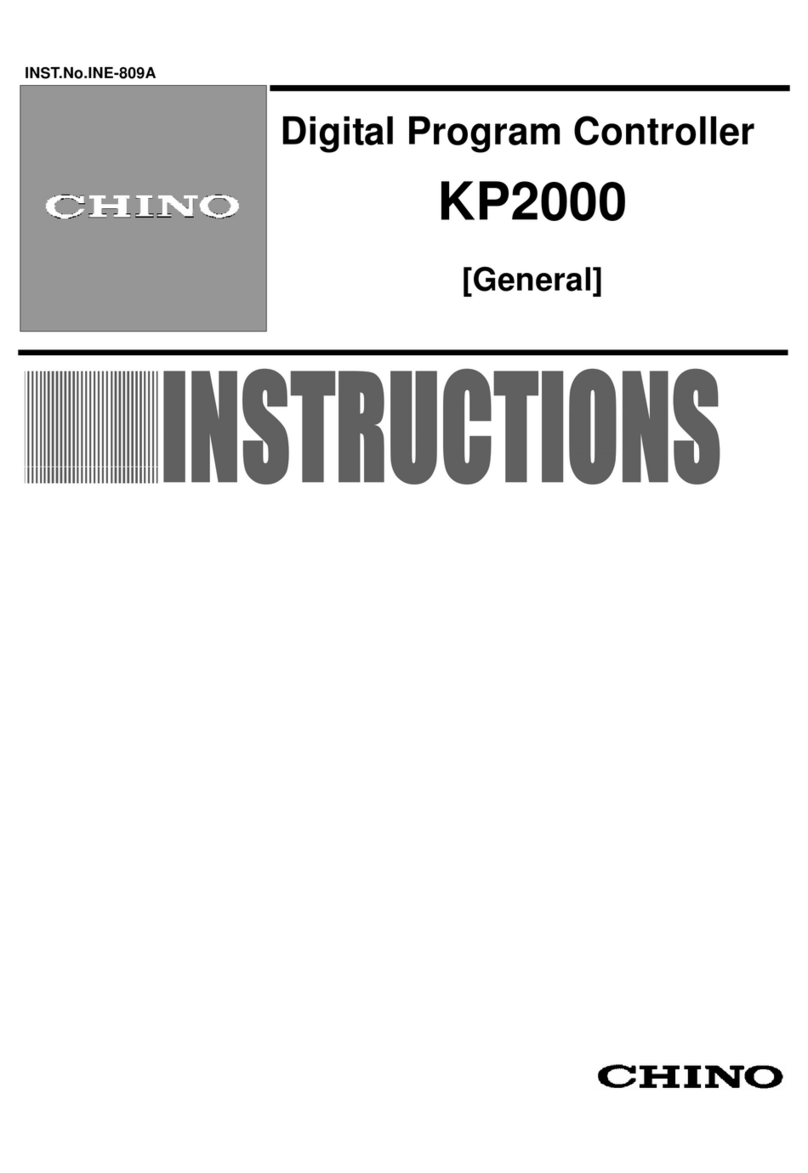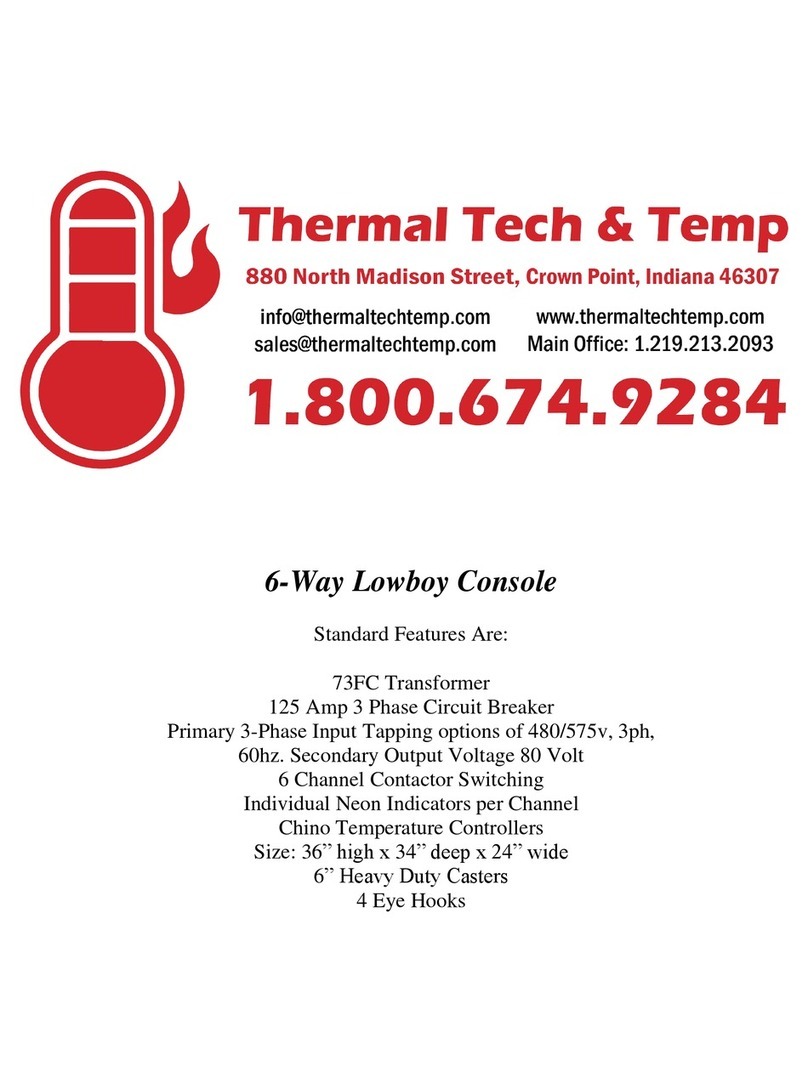
2
5. Specifications
5.1 Standard specifications
1) Input specifications
Input type: T/C … B, R, S, N, K, E, J, T, U, L ,WRe5 - WRe26,
W - WRe26,PtRh40 - PtRh20,PlatinelⅡ
RTD … Pt100, JPt100 DC voltage … 0 to 5V
DC current … 4 to 20mA (by adding a shunt resistor 250Ω)
Rated measuring accuracy: ±0.25% ± 1 digit (See the right upper
table in Chapter 9 for details.)
RJ compensation accuracy: At ambient 13 to 33ºC … ±1.0ºC
At ambient -10 to 50ºC … ±2.0ºC
Sampling period: Approx. 0.5 second
Burnout: Up scale (T/C, RTD )
Allowable signal source resistance: thermocouple …250Ωor less
DC voltage…1KΩor less
RTD…10Ωor less (per wire)
Input resistance: DC voltage, thermocouple … 1MΩor more
Maximum common mode voltage: 30VAC
CMRR (thermocouple): 130dB
SMRR (thermocouple): 50dB
2) Control specifications
Control switching period: About 0.5 second
Control output: Heating output/PID system, To be specified from the
following 4 types, Cooling output (option) is only 2
types of ①and ③.
①On-off pulse type …
Contact ratings: See “Cautions on wirings” in Chapter 2.
Pulse cycle: 1 to 180 seconds (1 second increments)
②Current output type … 4 to 20mA (600Ωor less)
③SSR drive pulse type …
Output signal: 12VDC ± 20% (Max 20mA) at ON
0.8VDC or less at OFF
Pulse cycle: 1 to 180 seconds (1 second increments)
④Voltage output type … 0 to 10VDC
(Output resistance … About 10Ω,
Load resistance…50kΩor more)
3) General specifications
Rated supply voltage: 100 to 240VAC 50/60Hz or 24VDC (Class 2
power source)
Allowable power voltage: 90 to 264VAC / 24VDC(± 10%)
Power consumption: Maximum about 14VA / about 8W
Operating condition: As shown in the following table.
Item Reference operating
condition Normal operating condition
Ambient temperature 23 ± 2ºC -10 to 50ºC *1
Ambient humidity 55 ± 5%RH *2 20 to 90%RH *2
Power voltage 100VAC ± 1% , 24VDC 90 to 264VAC,24VDC± 10%
Power frequency 50/60Hz ± 1% 50/60Hz ± 2%
Mounting angle Up/down …±3º Up/down …±10º
Installation altitude Less than 2000m Less than 2000m
Vibration, Impact 0m/s2, 0m/s22.0m/s2, 0m/s2
*1: Less than 40ºC for closed installation
*2: No dew condensation is allowed.
Warming up: More than 30 minutes
Power failure: Parameters are maintained by EEPROM.
Insulation resistance: Between primary terminal (*3) - secondary
terminal (*4) 500VDC, 20MΩor more
Withstand voltage: Between primary terminal (*3) - secondary
terminal (*4) 1500VAC, 1 minute
*3: Terminals for AC power supply, control output
and event relay output
*4: Terminals other than mentioned above and DC
power supply .
Front and case: Front…Non-flammable ABS
Case…Non-flammable polycarbonate resin
Weight: Approx. 450g(LT370), Approx. 350g(LT350),
4) Event specification
Event calculation: 3point
Output point: Transistor output 1point (EV1)
Relay output, 2 points (EV2, EV3) (option)
Event type: Absolute value , deviation , absolute value deviation ,
output value (High limit/low limit and standby
enable/disable is selectable in these events.), FAIL, heater
disconnection(option), timer function (EV1, EV2)
Contact ratings: See “Cautions on wirings” in Chapter 2.
5) Transportation and storage* condition
Ambient temperature: -20 to 60ºC
Ambient humidity: 5 to 95%RH (no dew condensation)
Vibration: 0 to 4.9m/s2 (10 to 60Hz)
Impact: 400m/s2 or less
*The above is under the condition of shipment from the factory
5.2 Options
1) Communications interface / Remote contacts input
Type: RS-232C, RS-422A or RS-485, to be specified
Protocol: MODBUS (RTU mode/ASCII mode selectable) and private
Function: Settings/data transmission, digital transmission or digital
remote, to be specified
Transmission speed: 9600/19200 bps
Remote contacts Input: 2 points
(No-voltage contacts or transistor open collector)
(Remote contacts rating…5VDC or more, 1mA or more)
Function: ①SV No. selection, ②Run/ready switching、③ Timer
start, ④Remote/local switching is selectable by settings.
2) Retransmission output
Output signal: 4 to 20mADC(load resistance…400Ωor less),
0 to 1VDC or 0 to 10VDC(output resistance…approx.10Ω,
load resistance…50KΩor more), to be specified
Output accuracy: ±0.2% of full scale
Resolution: About 1/30000
3) Heater disconnection (CT)
Input signal: 5.0 to 50.0 A AC (50Hz/60Hz)
Measuring accuracy: ±5%FS ± 1 digit
Recommended CT: Model CTL-6-S-H
4) Additional event output (EV2,EV3)
Output point: Relay output, 2 points
5) Water-proof … Not available in closed installation
Front panel protection: NEMA 250 4X(equivalent to IEC529 IP66)
Panel installation: See Chapter 1 “Installation to a panel”.
5.3 Parts (Separate purchase is required.)
1) Contact protection element … To be mounted externally
Type Specification Open/close current Application
CX-CR1 0.01µF+120Ω0.2A or less For light load
CX-CR2 0.5µF+47Ω0.2A or more For heavy load
2) Shunt resistor for current input … To be mounted externally
・Resistance … 250Ω
・Maximum allowable continuous current … 25mA
・Type … EZ-RX250
3) Terminal cover … To be mounted externally/nonflammable

